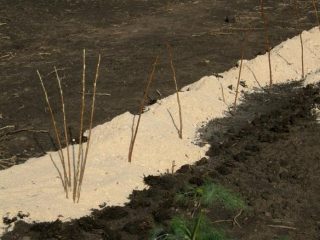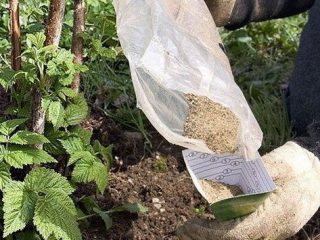Content
Amira raspberry is a famous Italian variety, bred more than 20 years ago. It is characterized by very large berries with a pleasant taste and pronounced aroma. The culture is winter-hardy and has good immunity. Therefore, such raspberries can be grown in almost any Russian region.
Breeding history
Raspberry Amira is a variety bred in 2000 on the basis of the Italian agricultural nursery Berryplant. The breeders took the Tulamin and Polka varieties as a basis. Initially it was given the name BP 1. However, the variety is better known under the Amira brand.
This variety is not included in the Russian register of selection achievements. However, it is widely known to many gardeners. It is distinguished by very large berries that appear both in summer and autumn. The variety's winter hardiness is high, which makes it possible to grow it even in the Urals and Siberia.
Description of Amira raspberry variety
The raspberry bush is quite tall, but not spreading.The berries are large, so they can be used not only for yourself, but also sent for sale or processing.
Berries
Amir raspberries are large, weighing on average 4-5 g, often reaching 6-8 g. The pulp is dense, whole, dry. The taste is good, sweet and sour. The aroma is pronounced. The shape is cone-shaped, oval, the color is bright red, practically does not change even after collection. The taste is not affected by rain or temperature changes.
Transportability and keeping quality are good. The berries are used fresh for preparing fruit drinks and other dishes. Suitable for any homemade preparations - jam, jam, compote.
Bush
Amir raspberry bushes are vigorous, reaching a height of 1.5-2 meters. The shoots are quite powerful, densely covered with thorns - Amira inherited this feature from her predecessor, the Tulamin variety. The branches grow vertically, so the crown is compact and not spreading. The harvest is quite large, so some shoots may lean towards the ground during the fruiting period - a garter is required.
The shoots have numerous laterals and are arranged in a cluster. Berries appear along the entire length. The leaves are bright green, rather large, with a wrinkled surface. The shape of the leaf blade is ovoid, the tip is pointed, the edges are serrated. The inner side is whitish.

The fruits are large, the drupes fit tightly together
Characteristics of Amira raspberries
Amira raspberries have moderate yields. The berries are large, beautiful and transportable. The variety's winter hardiness and disease resistance are also quite good. Therefore, not only experienced gardeners, but also novice amateurs can cope with growing shrubs.
Ripening time and yield of Amir raspberries
The ripening period of Amir raspberries is late: fruiting generally begins in late July or early August. At the same time, in the southern regions the wave occurs several weeks earlier. Interestingly, ripening continues until autumn, and the autumn harvest is larger than the summer one, and the berries are larger. The fruiting period is short - almost the entire harvest is harvested in a month (more than 80%).
Each bush produces up to seven shoots annually. In this case, the first (summer) berries can be collected from the branches of last year, and the second (autumn) - from the young ones that appeared in the current season.
Amira raspberries belong to the remontant varieties. This means that it produces crops in several waves. From one adult bush you can collect about 3 kg. This indicator can be achieved in any region. With industrial cultivation, the yield is 12-14 tons per hectare, sometimes up to 15-16 tons.
Frost resistance
The frost resistance of the Amir raspberry variety is quite high. Without shelter, the shoots can withstand up to -26 degrees. Young bushes need to be covered. When grown in the Urals or Siberia, all bushes, including adults, must be insulated.
Disease resistance
The resistance of the Amira raspberry variety to diseases is quite high. If you organize good care and do not give a lot of water, the bush will not suffer from infections. But during the season, an invasion of aphids or other pests may begin. Therefore, the bushes should be periodically inspected and, if necessary, treated with folk remedies or special preparations.
Advantages and disadvantages
Amira raspberries are valued for their very large and tasty berries. The drupes fit tightly together, so the fruits do not crumble. The yield is average, but the bushes are not spreading and do not take up much space.This variety is suitable for both personal and industrial cultivation.

The main wave of harvesting occurs in August
Pros:
- the berries are very large, marketable;
- the taste is excellent (even in bad weather);
- a pronounced aroma is felt;
- dry tear, firm flesh;
- keeping quality;
- transportability;
- high winter hardiness;
- can be grown in different regions;
- immunity is quite good.
Minuses:
- average yield;
- branches can sag and therefore need garter.
Features of growing Amir raspberries
Caring for Amir raspberries is quite simple. Shrubs need to be watered and fed regularly. Young seedlings are carefully covered for the winter. You can grow raspberries both in a greenhouse and in open ground.
Planting Raspberries Amir
Raspberry seedlings are purchased from nurseries or suppliers. When purchasing, pay attention to the condition of the shoots and roots - they must be healthy, without signs of disease. The planting site should be dry, lighted and protected from the wind. The deadline is planned for autumn (September) or spring (April, May). It is important that there are no return frosts, so sometimes it is worth delaying planting.
The area is first dug up and fertilized with organic matter or a complex product. If the soil is too dense, vermiculite, sand or sawdust should be added to it. When planting Amir raspberries, proceed as follows:
- Dig several holes 40*40 cm at a distance of at least 1-1.2 m.
- Lay a layer of small stones.
- Place the seedling in the center.
- Cover with fertile soil (mixture with peat, humus).
- Compact the soil so that the root collar remains slightly above (1-2 cm) the surface.
- Water with settled water (10 l).
- Lay a layer of mulch - hay, straw, sawdust, pine needles.
Amira raspberry care
To grow productive Amira yellow raspberries, as in the description of the variety and in the photo, it is recommended to pay attention to reviews from experienced summer residents. In the comments, gardeners describe the following care rules:
- Water weekly, in rainy weather - twice a month.
- Fertilizing with complex mineral fertilizers every two weeks (according to instructions).
- Regular loosening of the soil, weeding.
- During fruiting, sloping branches are tied to supports.
- Pruning in spring and autumn to remove diseased, old branches and form bushes.
- Thorough mulching for the winter. In frosty regions, branches are tied and covered with agrofibre and burlap.

Regular fertilizing ensures a good harvest
To cause a second wave of fruiting, it is recommended to shorten young shoots in the fall, leaving a third of the length. Then the new harvest can begin to be harvested as early as June next year.
Prevention of diseases and pests
To prevent powdery mildew, rot and other diseases, you need to:
- treat raspberries with fungicides in early spring;
- remove fallen leaves in autumn;
- be sure to trim diseased branches and shoots;
- observe the watering norm.
Fungicides are used for preventive and therapeutic treatments:
- Bordeaux mixture;
- "Skor";
- "Profit";
- "Tattu";
- "Abiga-Pik" and others.
It is also necessary to periodically inspect the Amir raspberry bushes for the presence of aphids, raspberry beetles, spider mites, leaf rollers and other pests. If they are detected, treatment with insecticides should be carried out:
- "Biotlin";
- "Confidor";
- "Inta-Vir";
- "Ephoria";
- "Agravertin" and others.
The seedlings are sprayed in the late evening or early morning, and the weather should be calm and dry.

To obtain a good harvest in the spring, it is necessary to carry out preventive treatment
You can also use biological preparations, for example, “Fitoverm”, “Respecta 25%”, “Bitoxibacillin”.
Conclusion
Amira raspberry is an interesting variety that produces tasty, large berries of a rich red color. The harvest is harvested in the second half of summer and early autumn. The culture is remontant - the fruits ripen in two waves. Moreover, the autumn harvest is usually even greater than the summer one. A description of Amir's raspberries in the video can be found here.








